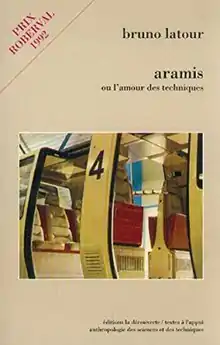 First edition (French) | |
| Author | Bruno Latour |
|---|---|
| Translator | Catherine Porter |
| Language | English |
| Publisher | La Découverte (France) Harvard University Press (US) |
Publication date | 1993 |
| Media type | Print (Hardback) |
| Pages | 336 (english translation) |
| ISBN | 978-0-674-04323-7 |
| OCLC | 277985319 |
Aramis, or the Love of Technology was written by French sociologist/anthropologist Bruno Latour. Aramis was originally published in French in 1993; the English translation by Catherine Porter, copyrighted in 1996, ISBN 978-0-674-04323-7, is now in its fourth printing (2002). Latour describes his text as "scientifiction," which he describes as "a hybrid genre... for a hybrid task" (p. ix). The genre includes voices of a young engineer discussing his "sociotechnological initiation," his professor's commentary which introduces Actor-network theory (ANT), field documents - including real-life interviews, and the voice of Aramis—a failed technology ([1] p. x).
The book is a quasi-mystery, which attempts to discover who killed Aramis (personal rapid transit). Aramis was supposed to be implemented as a Personal Rapid Transit (PRT) system in Paris. Simultaneously, while investigating Aramis's demise, Latour delineates the tenets of Actor-network theory. Latour argues that the technology failed not because any particular actor killed it, but because the actors failed to sustain it through negotiation and adaptation to a changing social situation.
Table of contents
- Preface
- Prologue: Who Killed Aramis?
- An Exciting Innovation
- Is Aramis Feasible?
- Shilly-Shallying in the Seventies
- Interphase: Three Years of Grace
- The 1984 Decision: Aramis Exists for Real
- Aramis at the CET Stage: Will it Keep its Promise?
- Aramis is Ready to Go (Away)
- Epilogue: Aramis Unloved
- Glossary
See also
References
- ↑ Latour, Bruno. (1996). Aramis, or the Love of Technology. Cambridge, MA: Harvard University Press.